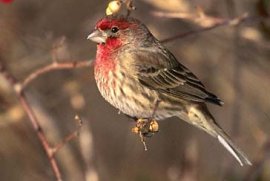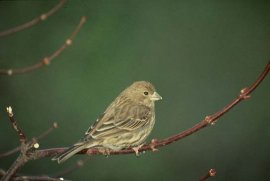Perching Birds
Description
5-6" (13-15 cm). Sparrow-sized. Most adult males bright red on crown, breast, and rump, but less extensively so than male Cassin's and Purple finches. Female has plain, unstriped head and heavy streaking on light underside. Immature males less highly colored, often orangish or yellowish on head and breast.
Voice
A chirp call like that of a young House Sparrow. The song is an extensive series of warbling notes ending in a zeee, canarylike but without the musical trills and rolls. Sings from a high tree, antenna, or similar post for prolonged periods.
Range
Resident throughout West, from southern Canada to southern Mexico, and east to Nebraska. Introduced and now widespread in eastern North America.
Discussion
House Finches are omnivorous, gleaning insect pests and, in winter, grass and weed seeds. Garden-bred birds join large field flocks during the fall, often feeding in farmers' fields, and may become agricultural pests. The eastern population of this species is descended from cage birds released near New York City in the 1940s. For years the birds barely survived on Long Island, but they then spread in suburban areas. In the late 1960s and 1970s they finally established themselves in urban New York, where their musical song and bright colors add a cheerful touch.




